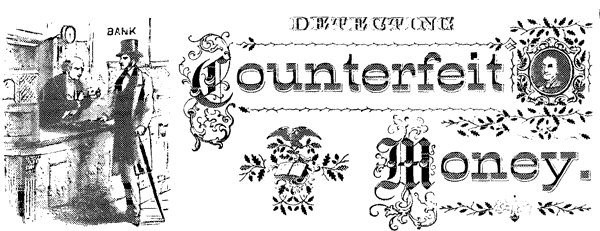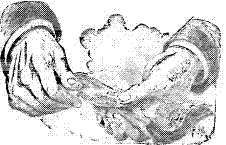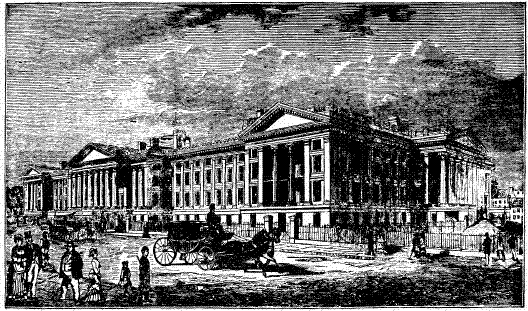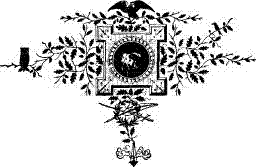 |
 |
|
|
|
|
 DETECTING COUNTERFEIT MONEY
The desire to accumulate property is one of the noblest that nature has implanted in man, and it is through the successful results of this desire, we are enabled to point with unerring certainty to the disembarking line, which so surely characterizes the advanced educated, refined and civilized man from that of the wild savage, whose highest desire is to slay and rob his fellow men, and proudly exhibit their scalps, or the plunder he has acquired, as evidence of his cunning or courage. It is through this inborn desire to accumulate that man is willing to labor, toil, suffer, and forego present gratifications for the hope of future greater satisfactions; that has resulted in the building and equiping the mighty ships of commerce, whose white, spreading canvas dots every sea where commerce may be known, or where the interests of God's creatures may best be served. It is through this desire, coupled with unremitting toil, that we owe everything of permanent enjoyment, of enlightenment and of prosperity. The millions of dollars of paper money which is handled every day as the natural fruit of toil and saving through the many and diversified transactions in the vast, illimitable and ever rapidly developing field of commerce, is but the representative of ownership of property. If this representative is what it purports on its face to be, each and every one who receives it in exchange for services or commodities, owns not merely a piece of paper, with designs, words and promises printed or engraved thereon, but an interest or an undivided whole in a farm, a block of buildings or a store well stocked with merchandise, which, in his estimation, at least, is more desirable to him than the labor or commodity for which he has voluntarily made the exchange; but, if on the contrary, it is other than what it purports on its face to be, he finds that he is the owner of a piece of paper whose value is nil. There is, at the present writing, 1884, nearly eight hundred million dollars of paper currency in the United States, consisting of greenbacks and national currency, a great portion of which is in actual circulation, and it has been estimated by eminent authorities, who occupy positions of trust in the various departments through which the financial machinery of this vast sea of paper money is daily circulated, that there is in circulation nearly one-fifth of this amount in counterfeit money, or about one hundred and sixty million dollars; and not one dollar of this counterfeit money owes its circulation to any excellence of the work in its manufacture, but wholly to the general ignorance of those who handle it, as to what is required to constitute a genuine bill. The time will come when the United States will redeem all of its issue of paper money, when those who are holding any of this counterfeit money will have to stand the loss to the extent of the sum in their possession. To all of those who are willing to take a small portion of their time each day for a few weeks in learning just what it takes to constitute a genuine bill, there need be no necessity of ever losing anything by counterfeiters, as it is impossible for them to make bills which will in any way approach the beauty and exactness of the genuine ones. There is not at the present time, nor has there ever been in the past, nor will there ever be in the future, a counterfeit bill made that cannot be detected at sight; and the positive knowledge of how to know at all times when a bill is genuine and when not is within the reach of all those who may have the privilege of reading the following information or infallible rules with a genuine desire to be benefitted thereby. DEVICES AND FRAUDS.Various devices are resorted to by a numerous gang or body of persons, to get on in the world without turning their attention to legitimate and useful employments. This class includes many that are not engaged in the practice of counterfeiting and putting forth bad money, but who make themselves felt in various ways through vain tricks and schemes, which are, to all intents and purposes, frauds. Business men are generally apt at detecting and turning off petty schemes, but they find it best to have the means with which they may deal successfully as against regular swindlers, forgers and counterfeiters. COUNTERFEIT AND GENUINE WORK. DETECTING COUNTERFEIT MONEY As indicated above, counterfeit notes are issued and put into the channels of circulation in abundance every year by those engaged in the practice of counterfeiting. These notes are often such good imitations of the genuine that it is quite difficult to discern the difference. That he may protect himself, each business man should have some definite knowledge of a genuine bank-note. The engraving of a genuine bank note, in most all of its parts, is done by machinery, and it is more exact and perfect. On the contrary, most all parts of counterfeit notes are done by hand. Counterfeiters cannot afford to purchase machinery, such as is used for the production of genuine notes. The cost of such machinery is between $100,000, and $150,000, and if it were in wrong hands it would be always liable to seizure and confiscation. In order to prevent the forgery of bank-notes, a great deal of ingenuity and art has been expended on their production. The principal features of the manufacture are described as a peculiar kind of paper and water mark; an elaborate design, printed with a peculiar kind of ink, and certain private marks, known only by the bank officials. The work of counterfeiters can never equal that of the makers of genuine notes, whose skill and facilities for producing the highest grade of work known to the art, are the best that the world affords. Unless one is somewhat learned as to the quality of engraving, that he may be able to distinguish a fine specimen of the art when he sees it, he is likely to become a victim of the counterfeiter's operations. LATHE WORK.When the genuineness of a bank-note is doubted, the Lathe Work on the note should first be closely scrutinized. The several letters of denomination, circles, ovals, and shadings between and around the letters in the words, etc., are composed of numberless extremely fine lines—inclusive of lines straight, curved and network. These are all regular and unbroken, never running into each other, and may be traced throughout with a magnifying glass. Without the skill or machinery, by which the genuine is produced, the same quality of work cannot be done. Therefore, in a counterfeit, the lines are imperfect, giving the paper a dull or hazy aspect, that may be all the better appreciated by comparing it with the genuine. The lines in the counterfeit will be found now and then irregular in size, and broken: not uniform in course, sometimes heavy, sometimes light: no two stamps or dies on the same note being exactly alike. The fine, uniform, shade-lines, with which the letters on the genuine are embellished, are wrought by a machine that cannot be reproduced by counterfeiters, nor used for other than legitimate purposes, by authority. GEOMETRICAL LATHE.The fine line is the characteristic of the various and beautiful figures which are seen on a genuine note. This line is produced by what is called the Geometrical Lathe. The patterns made by the geometrical lathe are of every variety of form. They are not engraved directly upon the bank-note plate, but on pieces of soft steel plate, which are afterwards hardened. The impressions are then transferred to a soft steel roller, which, in its turn, is also hardened, and the impressions remain there, in relief. This roller is then capable of transferring the same designs to the bank-note plate by means of the transfer press. In counterfeit engraving, the design is made directly upon the plate, and not by transfer, as in the production of plates for genuine notes. The essential difference between the two methods of production is, the counterfeit is made by hand, and is inexact and imperfect, while the genuine is made on geometrical principles, and is therefore exact, artistic and beautiful. In all the government issues the geometric lathe work is liberally used. This should be studied carefully, as it constitutes the chief test of genuineness. Fine lines, of unerring exactness, never broken, are seen on the genuine medallion heads, or shields, upon which the designation of the note is sometimes stamped. This nicety cannot be given by hand, or with the use of imperfect machinery. By close scrutiny the lines will be found to break off in the pattern, or appear forked, irregular in size, and not well defined throughout. On most counterfeits the vignettes are not well engraved, and the portraits have a dull appearance; the letters are usually wanting in clearness; the printing is sometimes faulty, by which some features of the note are obscured. RULING ENGINE WORK.
In Ruling Engine Work, as it is called, the fine line is present, also. The engraving is produced and transferred in the same way as the geometrical lathe work. In this they are parallel and not in circles. Those which constitute the shading of letters are so fine that they form a perfectly even gray shade. They may be printed so that the shading will appear darker, but the aspect will be uniform. The spaces between lines are exact, whether the lines be horizontal or diagonal. The lines are also made crooked or wave-like, not absolutely parallel. Ruling engine work is generally used for shading of names of banks, and also for the names of town, state, etc. VIGNETTES.While lathe work and that of the ruling engine are invariably machine work, and therefore cannot be successfully reproduced by counterfeiters, the Vignettes are chiefly the work of the hands. In all genuine work they are made by first class artists, who are well paid for their services, and who therefore have no incentive to exercise their skill for illegitimate purposes. Sometimes water and sky are done with the ruling engine, and when they are, no counterfeiter can successfully imitate them. Fine vignettes are seldom seen on counterfeit notes. If the lathe and ruling engine work be genuine, an ordinary vignette cannot make a note counterfeit, and if that be counterfeit, no vignette can make the note genuine. The vignettes on genuine notes are executed by men at the head of their vocation, and are very life-like and beautiful. Counterfeit vignettes usually have a sunken and lifeless appearance. Genuine vignettes, as seen upon government issues, consist of out-door scenes, portraits, historical pictures, and allegorical figures. They are all exceedingly beautiful, and it is not likely that such work will ever be successfully imitated. SOLID PRINT.The lettering, or solid print, in genuine work is done by a first-class artist, who makes that kind of work his exclusive concern. The name of the engraving company is always engraved with great pains and is very accurate. It will be seen on the upper and lower margin of the note. This, in counterfeits, is not quite uniform or even. The words "one dollar," as on the one dollar greenbacks, are to be considered as a sample of solid print. BANK-NOTE PAPER.Bank-notes are printed upon paper composed of linen, the qualify of which is not always the same, and it varies in thickness. Therefore, the paper is not always a sure test, but it is important. The manufacture of this paper is a profound secret, as carefully kept as the combinations to the great vaults where the government's millions lie awaiting further river and harbor bills. It is made only at the Dalton mill, which dates back almost to colonial days. What its combinations are nobody knows except those intimately connected with its manufacture. The secret of the paper-making is jealously guarded, as is also the paper itself. From the moment it is made until it gets into the treasury vaults it is carefully guarded. It goes there in small iron safes, the sheets carefully counted, and all precautions against its loss being taken both by the government officials and by the express companies which carry it. COUNTERFEIT SIGNATURES.Sometimes genuine notes are stolen before they are signed; then the only thing about them made counterfeit is the signatures. Those who are familiar with the signatures of the officers of the bank where notes are purloined, may not be lead into error, as such signatures usually appear more or less cramped or unsteady; but there is no sure protection against a counterfeit of this kind for those who do not have special knowledge of the signatures.  UNITED STATES TREASURY BUILDING, WASHINGTON, D.C. ALTERED BANK-NOTES.Bank-notes are altered in two ways, namely: raising the denomination, and changing the name of a broken to that of a responsible bank. First, in altering a note, it is scraped until thin: then figures of larger denomination are pasted over. A pasted note may be detected by holding it up to the light, when the pasted parts will appear darker, as they are thicker. Second, the denomination of a note is raised by taking out a low one with an acid, and printing in a higher one with a counterfeit stamp. The ink used in genuine bank-note printing is a peculiar kind, and not easily to be obtained by counterfeiters: therefore, their printing will not appear as clear and bright as that of the government, which is done with ink of the finest quality. If the ink is black, it gives a clear and glossy impression, without any of that smutty appearance, as is sometimes seen in counterfeit bank-notes. It is almost impossible to imitate the green ink that is used by the government, and it is nearly as difficult to imitate the red and other colors. Counterfeit inks look dull and muddy, while genuine inks have a glossy appearance. In the case of a note altered by the use of acid, it may be noticed that the acid, by spreading more than was intended by the counterfeiter, has injured parts of other letters, and the paper will appear more or less stained by the acid. COMPARING AND EXAMINING NOTES.A counterfeit should be compared with one that is genuine, in order to familiarize one's self with the distinguishing features which have already been indicated. It is best to acquire the habit of giving each note as received a searching glance, turning it over to see the back, and if there be any defect, it will probably catch the eye. If there be the least suspicion, a critical examination of all its parts should be made. In case of doubt, the lathe work should be carefully examined, and it may be compared with a perfectly good bill; then examine the shading around the letters, and search for any sign of alteration in the title or denomination of the note. If there are any medallion heads or shields, notice the lines; if there is any red letter work, designed to appear on both sides, look at the character of the work on the face, then turn the note and examine the back. If the printing is not exactly alike on both sides, but varies in any part the note is counterfeit. Then observe the vignettes and portraits, to see whether their style and perfection compare well with the work on genuine notes. Then examine the solid print and engravers' names, as well as the printing, ink, and paper. By such thorough examination, one can hardly be at a loss to determine the status of the note. Good magnifying glasses are necessary, in most instances, to bring out the fine lines on bank-notes. Sometimes a microscope of great power is required to discern the genuine line. PIECING, ETC.Counterfeiters sometimes make ten bills of nine by what is termed piecing. Thus, a counterfeit note is cut into ten pieces by the counterfeiter, and these pieces are used in piecing nine genuine bills, from each of which a piece has been cut. The nine genuine pieces, thus obtained, are then pasted together, and with the tenth counterfeit piece added, make a tenth bill, which is the gain. Piecing bank-bills is not a very successful practice. One who possesses such information as here given, can readily detect the difference between the counterfeit and the genuine. This difference is, however, made less apparent by the counterfeiter, who defaces the counterfeit part, so as to give the note a worn appearance. Counterfeiting is rendered very difficult in consequence of the remarkable excellence of the work on the government and national currency, as also from the difficulty of imitating the green. But this currency, if successfully imitated by counterfeiters, will repay large outlay and care, as the greenbacks pass anywhere in the nation, and a counterfeit may be carried to other states or sections as it becomes known in any particular locality. National bank currency may be counterfeited by preparing a plate, and then with simple change in the name of the bank the counterfeit can be adapted to the various towns where banks are located. This much is written, not to lessen the value of or confidence in the issues of the government, but to admonish the public against the dangers of a false security. 
|
|
|